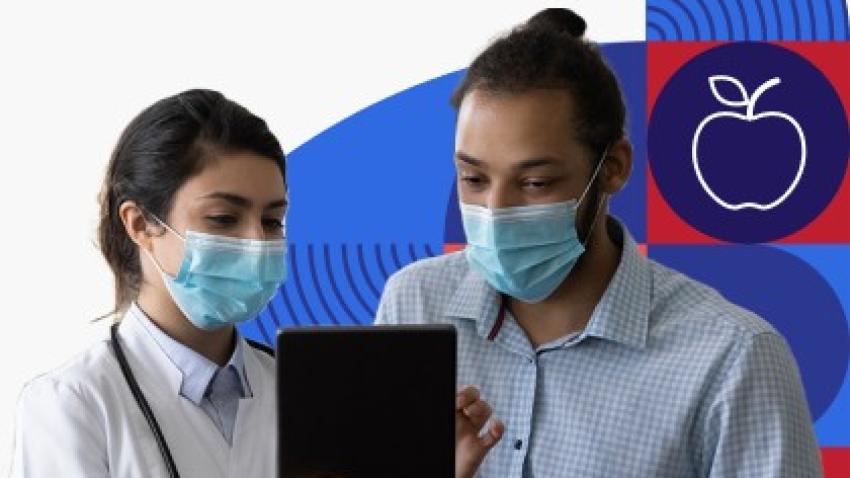Health Conditions
Take Steps to Prevent Skin Cancer

The Basics
Overview
Most skin cancers are caused by contact with ultraviolet (UV) rays from the sun and other sources of UV radiation, like tanning beds.
Limiting your contact with UV radiation lowers your risk of skin cancer. To protect your skin from damage caused by UV radiation:
- Stay out of the sun as much as possible between 10 a.m. and 4 p.m., when the sun’s rays are strongest
- Cover up with long sleeves, long pants or a long skirt, a hat, and sunglasses
- Put on broad spectrum sunscreen with SPF 15 or higher
- Don’t use indoor tanning machines
A change on your skin — like a new growth or mole, a sore that won’t heal, or a change in an old mole — is the most common sign of skin cancer. If you notice a change in your skin, talk to your doctor.
Read more about how to protect yourself from skin cancer.
Why do I need to protect my skin?
Protecting your skin from the sun and other UV radiation today may help prevent skin cancer later in life. Most skin cancer appears later in life, but skin damage from the sun can start during childhood.
Taking steps to protect your skin may also help prevent:
- Wrinkles
- Blotches or spots on your skin
- Other damage to your skin and eyes
Definition
What is skin cancer?
Skin cancer is the most common kind of cancer in the United States. There are 3 main types of skin cancer:
- Basal cell carcinoma
- Squamous cell carcinoma
- Melanoma
Basal cell carcinoma and squamous cell carcinoma are also called nonmelanoma skin cancer, and they’re much more common than melanoma. Melanoma is the most dangerous type of skin cancer.
Skin cancer can almost always be cured when it’s found and treated early. That’s why it’s important to check your skin regularly for new growths (like moles or lumps) or changes in old growths. Tell your doctor or nurse right away if you notice a change.
To learn more about skin cancer, check out:
Am I at Risk?
What causes skin cancer?
Ultraviolet (UV) radiation from the sun is the main cause of skin cancer. UV radiation can also come from tanning beds, tanning booths, or sunlamps.
Anyone can get skin cancer. You’re at higher risk if you have:
- Fair (light-colored) skin with freckles
- Skin that burns easily or doesn’t tan easily
- Blond or red hair
- Blue or green eyes
You’re at higher risk for melanoma, the most dangerous type of skin cancer, if you have:
- Unusual moles (moles that change color, grow unevenly, or change in texture)
- A large number of moles (more than 50)
- Fair skin that burns easily
- A family history of melanoma or unusual moles
- A personal history of frequently coming in contact with sunlight or UV radiation
- A personal history of many blistering sunburns, especially when you were a child or teenager
Find out more about unusual moles and melanoma risk. And be sure to talk with your doctor or nurse if you have any concerns.
Can people with dark skin get skin cancer?
Yes. Anyone can get skin cancer, even people with dark skin — like Black or African American people. That’s why it’s important to protect your skin from the sun — even if you don’t get sunburns easily — and to check your body for signs of skin cancer regularly.
Keep in mind that people with dark skin may get melanoma on parts of the body you might not expect, like:
- The palms of the hands
- The bottoms of the feet
- Under the nails
Take Action
Protect Your Skin from the Sun
Take these simple steps to help prevent damage to your skin.
Stay out of the sun between 10 a.m. and 4 p.m.
The sun’s rays are the strongest from mid-morning to late afternoon. Try to stay out of the sun during these hours. If you're outside, stay in the shade — like under a tree or umbrella.
Cover up with long sleeves, a hat, and sunglasses.
Wear a long-sleeved shirt and long pants or a long skirt when you spend time outdoors. Clothes made from tightly woven fabrics are best for blocking UV rays.
Wear a hat with a wide brim that protects your face and neck. Avoid straw hats with holes that let sunlight through. If you wear a baseball cap or visor, be sure to protect your ears and the back of your neck with sunscreen.
It’s also important to wear sunglasses that block UV light. This will help protect your eyes and the skin around them from sun damage. Wrap-around sunglasses are best because they block UV rays from the side and the front.
Use sunscreen with SPF 15 or higher.
Use sunscreen with both UVA and UVB protection, also called broad spectrum sunscreen. Check the expiration date on the bottle to make sure it’s not out of date.
To get the most protection:
- Wear sunscreen even on cloudy days — UV rays can still harm your skin when it's cloudy outside
- Put sunscreen on 30 minutes before you go outside — and put on more sunscreen every 2 hours and after you swim or sweat
- Be sure to use enough sunscreen — you’ll need about a handful to cover your whole body
- Remember to apply sunscreen to your ears, hands, feet, the back of your neck, and any part of your scalp that isn’t covered by hair
- Use lip balm with sunscreen in it to protect your lips
- If you wear very lightweight or loosely woven clothing (like a beach cover-up or thin T-shirt), put sunscreen on under your clothes
Healthy Habits
Don’t use indoor tanning machines.
Tanning beds, tanning booths, and sunlamps are not any safer than tanning in the sun.
Just like tanning in the sun, indoor tanning can cause skin cancer, wrinkles, age spots, and other damage to your skin and eyes.
Check your skin regularly.
See a doctor or nurse right away if you notice:
- A new growth (like a mole or lump) on your skin
- An existing growth that has changed in size, shape, color, or feel
- A mole that bleeds or a sore that doesn’t heal
Most skin changes are harmless, but only a doctor or nurse can tell you for sure. Some doctors may recommend that you check your skin at home. Learn more about checking your skin for cancer.
Keep in mind that skin cancer might look different on dark skin than on light skin. Learn more about skin cancer in people with dark skin.
Content last updated May 23, 2024
Reviewer Information
This information on protecting your skin from the sun was adapted from materials from the National Cancer Institute, the Office on Women’s Health, and NIHSeniorHealth.gov.
Reviewed by:
Rebecca Chasan, PhD
Chief, Science Writing and Review Branch
National Cancer Institute
National Institutes of Health
Ann Pluta, PhD
Scientific Communications Editor, Office of Communications and Public Liaison
National Cancer Institute
National Institutes of Health


